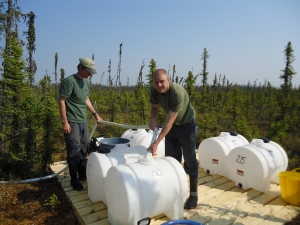Villanova University Researchers Part of Team in Determining the Critical Load of Atmospheric Nitrogen Endangering Northern Alberta Peat Bog Ecosystems

Photo Credit: Villanova University
By Villanova University
6/19/2019
Three Villanova University researchers, part of a team that through a five-year study in Alberta, Canada determined the “critical load”—or recommended maximum amount of nitrogen that can enter the region’s peat bogs through precipitation without causing damage to its ecosystem—have released their findings in an article published June 18 in Ecological Monographs.
Titled “Experimental Nitrogen Addition Alters Structure and Function of a Boreal Bog: Critical Load and Thresholds Revealed,” the article details how R. Kelman Wieder, a professor in Villanova’s Department of Biology, Melanie Vile, an assistant professor in Villanova’s Department of Geography and the Environment, and Kimberli Scott, Research Associate in Biology, worked together with researchers from Southern Illinois University* in experimentally applying nitrogen-enriched simulated rainfall to a pristine bog in order to quantify plant, soil and chemical responses. The group recommended that the critical load of nitrogen should be set at 3 kg of nitrogen per hectare per year.
They also discovered that, in comparison, development of the region’s vast Oil Sands Administrative Area, which mines or drills for bitumen—a heavy, thick oil that coats grains of sand and other minerals in a deposit that covers about 54,900 square miles—has increased the atmospheric nitrogen deposition in rain and snow in that area to 17 kg per hectare per year, almost six times that of the researchers recommended critical load.
Read more here: https://www1.villanova.edu/villanova/media/pressreleases/2019/0619.html